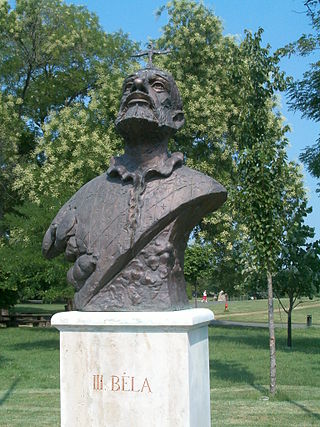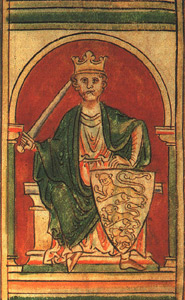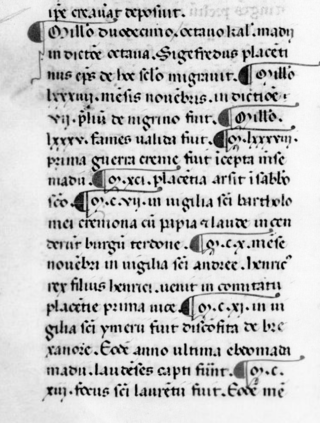Related Research Articles

A chronicle is a historical account of events arranged in chronological order, as in a timeline. Typically, equal weight is given for historically important events and local events, the purpose being the recording of events that occurred, seen from the perspective of the chronicler. A chronicle which traces world history is a universal chronicle. This is in contrast to a narrative or history, in which an author chooses events to interpret and analyze and excludes those the author does not consider important or relevant.

Richard I was King of England from 1189 until his death in 1199. He also ruled as Duke of Normandy, Aquitaine and Gascony; Lord of Cyprus; Count of Poitiers, Anjou, Maine, and Nantes; and was overlord of Brittany at various times during the same period. He was the third of five sons of Henry II of England and Eleanor of Aquitaine and seemed unlikely to become king, but his two elder brothers predeceased their father. Richard is known as Richard Cœur de Lion or Richard the Lionheart because of his reputation as a great military leader and warrior. The troubadour Bertran de Born also called him Richard Oc-e-Non, possibly from a reputation for terseness.

Year 1172 (MCLXXII) was a leap year starting on Saturday of the Julian calendar.

The Third Crusade (1189–1192) was an attempt led by three European monarchs of Western Christianity to reconquer the Holy Land following the capture of Jerusalem by the Ayyubid sultan Saladin in 1187. For this reason, the Third Crusade is also known as the Kings' Crusade.
Thomas Walsingham was an English chronicler, and is the source of much of the knowledge of the reigns of Richard II, Henry IV, Henry V and the latter reign of Edward III depicting the decline of the state of affairs of the English. He also documented the careers of John Wycliff and Wat Tyler.
It is believed that the first Jews in England arrived during the Norman Conquest of the country by William the Conqueror in 1066. The first written record of Jewish settlement in England dates from 1070. They suffered massacres in 1189–90. In 1290, all Jews were expelled from England by the Edict of Expulsion.

Roger of Howden or Hoveden was a 12th-century English chronicler, diplomat and head of the minster of Howden in the East Riding of Yorkshire.

The Rhineland massacres, also known as the German Crusade of 1096 or Gzerot Tatnó, were a series of mass murders of Jews perpetrated by mobs of French and German Christians of the People's Crusade in the year 1096, or 4856 according to the Hebrew calendar. These massacres are often seen as the first in a sequence of antisemitic events in Europe which culminated in the Holocaust.
Events from the 1190s in England.
Hawise, Countess of Aumale was ruling Countess of Aumale from 1179 until 1194 with her husbands. She was the daughter and heiress of William, Count of Aumale and Cicely, daughter and co-heiress of William fitz Duncan. She became Countess of Essex by her marriage to William de Mandeville, 3rd Earl of Essex.
Sir Osbern Pentecost was a Norman knight who followed Edward the Confessor to England upon Edward's return from exile in Normandy in 1041.

Richard Coer de Lyon is a Middle English romance which gives a fictionalised account of the life of Richard I, King of England, concentrating on his crusading exploits. It influenced Shakespeare's King John and Walter Scott's The Talisman.
Ferdinand was an infante, the second son and heir apparent of Alfonso VIII of Castile by his wife, Eleanor of England. He died unmarried at the age of 22, a little less than three years before his father.

The Battle of Chesterfield was a minor skirmish in the latter stages of 13th-century England's Second Barons' War.
The 1185 East Midlands earthquake happened in England. It is the first earthquake in England for which there are reliable reports indicating damage. The moment magnitude of the shock was estimated to be above 5.0 and its intensity was placed at VII (Damaging) on the European macroseismic scale.

The Guelph Annals of Piacenza is a Latin chronicle of Piacenza and Lombardy for the years 1031–1235, written by Giovanni Codagnello.

The Ghibelline Annals of Piacenza is an anonymous Latin chronicle of Piacenza from 1154 to 1284.
References
- Bale, Anthony P. (2000). "Richard of Devizes and Fictions of Judaism". Jewish Culture and History. 3 (2): 55–72. doi:10.1080/1462169X.2000.10512220. S2CID 162234460.
- Partner, Nancy (2011). "Richard of Devizes: The Monk Who Forgot to be Medieval". In Glenn, Jason (ed.). The Middle Ages in Texts and Texture: Reflections on Medieval Sources. University of Toronto. p. 231. ISBN 978-1442604902 . Retrieved 1 June 2016.
- This article incorporates text from a publication now in the public domain : Davis, Henry William Carless (1911). "Richard of Devizes". Encyclopædia Britannica . Vol. 23 (11th ed.). p. 298.